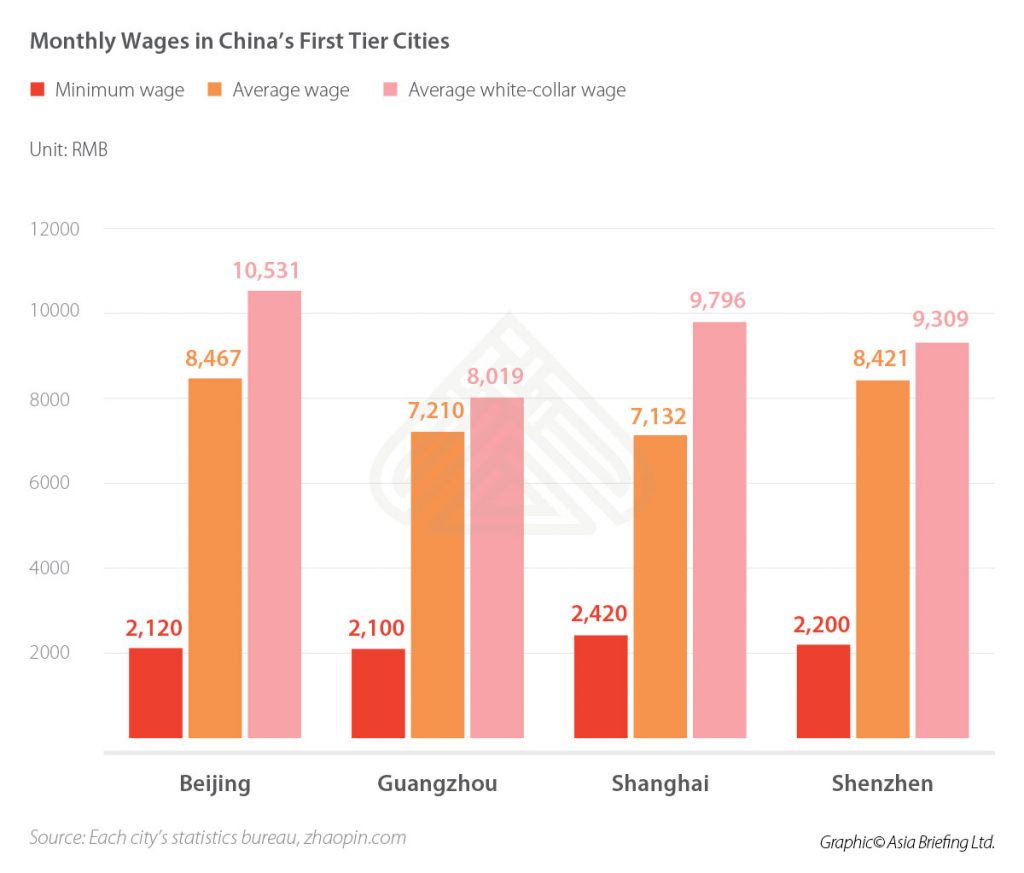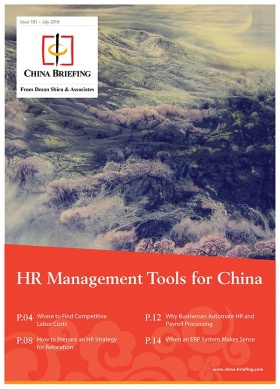Labor Cost Comparison of China’s First-Tier Cities

China’s top tier cities are among the world’s most popular investment destinations.
In the first half of 2018, first tier cities—Shanghai, Shenzhen, Beijing, and Guangzhou—showed a GDP growth of more than six percent—with Shenzhen even reaching eight percent, attributed to their level of economic development, rapidly growing innovation capabilities and incentives for attracting foreign talent.
Naturally, these cities have the highest demand for talent in the country, causing wages to increase and resulting in a more expensive labor market overall.
In this article, we compare and contrast the relative wage structures of China’s first-tier cities, focusing on the minimum, average and white-collar average wages as the labor metric of comparison.
Foreign investors need to keep a close eye on labor metrics to maintain cost efficiency and business viability.
Minimum Wages
Minimum wage not only relates to GDP and GDP per capita but also to the growth of the local economy and government policies.
Recent increases in minimum wage have been less frequently—possibly attributed to structural reforms by local governments, China’s recent economic downturn and an emphasis on lowering operational costs.
Shanghai, Shenzhen, Beijing, and Guangzhou have recorded the highest minimum wages in China this year, with all four cities having adjusted their minimum wage rates within the last 12 months.
Shanghai is the city with the highest monthly minimum wage in China. This year, the monthly minimum wage and hourly minimum wage increased by five percent to RMB 2,420 (US$354) and RMB 21 (US$3.1) respectively. Over the past decade, the minimum wage in Shanghai has increased by a factor of 1.7.
Shenzhen, the city with the second highest minimum wage, raised its minimum by 3 percent to RMB 2,200 (US$ 322). Similarly, its hourly minimum wage for part-time labor increased by four percent to amount to RMB 20.30 (US$3). The incremental year-on-year wage increase is intended to double the city’s per capita income between 2010 and 2020.
Ranked in third place, Beijing’s monthly minimum wage is RMB 2,120 (US$310) and hourly minimum wage is RMB 24 (US$3.50), increasing by six percent and nine percent respectively. Although, Beijing typically adjusts its minimum wage levels on an annual basis, this year’s increase was slightly higher than anticipated.
Of the four first-tier cities, Guangzhou has the lowest monthly minimum wage. Guangzhou has adjusted both its monthly minimum wage and hourly minimum wage for part-time employment by 10 percent – to RMB 2,100 (US$307) and RMB 20.30 (US$2.30) respectively. This was the first minimum wage adjustment in Guangdong province (excluding Shenzhen) since 2015.
To maintain its global competitiveness as China’s manufacturing hub and prevent manufacturers from moving to Southeast Asia, in 2017, the Guangzhou government stated that it would adjust the minimum wage every three years instead of every two years.
Average Wages
In contrast to minimum wages, average wages can often reflect a city’s strategy for upgrading and stimulating industrial transformation.
In Shanghai, the monthly average wage in 2017 was RMB 7,132 (US$ 1,056), a 9.7 percent increase from the previous year. The local government has not released statistics for monthly average wages for either non-private or private units for 2017. However, in 2016, the monthly average wage in non-private units was RMB 9,994 (US$ 1,505).
In Shenzhen, the monthly average wage in 2017 for all types of businesses was reportedly at RMB 8,421 (US$1,247). The average wage in non-private units in Shenzhen was RMB 8,261 (US$1,224), while the average wage in private units was RMB 4,941(US$732). This was the fifth consecutive year that Shenzhen had the highest average wage in Guangdong.
In Beijing, the monthly average wage for all types of businesses was RMB 8,467 (US$1,254). This was the first year that the city’s annual average wage exceeded RMB 100,000 (US$148,148). In urban areas, the monthly average wage in all types of non-private units was RMB 10,975 (US$ 1,625), an increase of 9.8 percent from 2016. In contrast, the monthly average wage in foreign-funded enterprises was considerably higher at RMB 14,615 (US$2,165). Consistent with other first-tier cities, the average wage in private units was also lower at RMB 5,894 (US$873), a seven percent increase from last year.
Beijing’s monthly average wage was almost 20 percent higher (amounting to RMB 1,335 or US $197) than that of Shanghai. This is, at least in part, due to headquarters of many financial institutions, state-owned enterprises, and information software industries often being situated in Beijing.
In Guangzhou, the average monthly wage in 2017 was RMB 7,210 (US$1,068). However, the average wage and growth rates of both private and non-private units in Guangzhou are all above the national average. Within non-private units (mostly state-owned enterprises, foreign-invested enterprises, and large and medium-sized enterprises) the average monthly wage was slightly higher at RMB 8,126 (US$203). Conversely, the monthly average wage in private units (businesses registered and controlled by individuals and labor-intensive small-medium enterprises) was lower at RMB 5,103 (US$756). Both numbers reflect more than an eight percent increase from 2016.
Average wages also differed considerably according to the type of business ownership. For example, while the average wage was RMB 8,373 (US$1,240) in foreign enterprises and RMB 8,310 (US$1,231) in state-owned enterprises, it was RMB 6,455 (US$956) in private enterprises. In Guangdong, the wage levels of foreign-funded enterprises and state-owned enterprises have levelled out in recent years.
White-collar Average Wages
According to the 2018 Report on Chinese Employers’ Demand and the Supply of White-Collar Talent in Summer, released by Zhaopin, the top three average white-collar wages in China are Beijing, Shanghai, and Shenzhen, with average monthly wages of RMB 10,531 (US$1,543), RMB 9,796 (US$1,435), and RMB 9,309 (US$1,364) respectively. Guangzhou came in at fifth place with an average white-collar average wage of RMB 8,019 (US$1,175), just behind Hangzhou with an average wage of RMB 8,585 (US$1258)
In Shanghai, industries with the highest monthly average wages were; investment funds or securities funds (at RMB 12,809 or US$1,877), intermediary services (at RMB 12,783 or US$1,873), and professional services (RMB at 12,518 or US$1,834).
In Shenzhen, cross-disciplinary operations across all white-collar sectors demonstrated the highest monthly average wage at RMB 12,260 (US$1,797). The average monthly salary in Shenzhen’s financial sector, at RMB 14,646 (US $2,146), is far higher than that of other cities in the region. Additionally, Shenzhen also offers wage advantage in other pillar industries, such as information technology (IT) as well as the city’s energy, mineral and mining industry.
Similarly, in Beijing, the following industries recorded the highest monthly average wage in 2017: finance (at RMB 12,079 or US$1,770), IT industry (at RMB 10,367 or US$1,519), and real estate (at RMB 6, 905 or US$1,012).
While the intermediary service industry in Guangzhou paid the highest monthly average wage (RMB 12,489 or US$1,830) in the city, followed by trust, guarantee, auction, pawn (RMB 10,976 or US$1,608) and the professional services and consulting industry (RMB 10,932 or US$1,602).
Implications for Foreign Invested Enterprises
In China, average wages in listed companies and joint ventures tend to be the highest. The larger the scale of the enterprise, the higher will be the average wage level. Further, the industries in which the highest white-collar average wages are recorded are often consistent from city to city—and often considered to be the industries with which China concentrates its efforts in talent attraction have the highest demand of white-collar workers.
Despite local governments’ efforts in capping minimum wages, average white-collar wages in urban areas continue to increase annually. If left unregulated, this may potentially lead to a widening gap between the rich and the poor in China.
Foreign-invested enterprises in China should stay ahead of labor trends—paying particular attention to minimum and average labor costs in each city—to ensure that decisions regarding office location and structuring a salary package are made appropriately.
About Us
China Briefing is produced by Dezan Shira & Associates. The firm assists foreign investors throughout Asia and maintains offices in China, Hong Kong, Indonesia, Singapore, Russia, and Vietnam. Please contact info@dezshira.com or visit our website at www.dezshira.com.
- Previous Article Nuovi controlli sulle risorse umane in Cina: dal 2019 sarà l’ufficio delle imposte a riscuotere i contributi di previdenza sociale
- Next Article Why Businesses Automate HR and Payroll Processing in China








